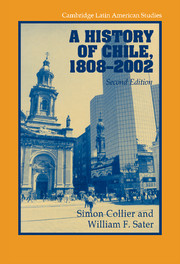Book contents
- Frontmatter
- Contents
- List of maps
- Preface to the Second Edition
- A note on geography
- CAMBRIDGE LATIN AMERICAN STUDIES
- PART I Birth of a nation-state, 1800s–1830s
- PART II The rise of a republic, 1830s–1880s
- 4 A time of progress, 1830s–1870s
- 5 The Liberal impulse, 1841–76
- 6 Crisis and war, 1876–83
- PART III The nitrate era, 1880s–1930s
- PART IV Industrial advance and the dawn of mass politics, 1930s–1960s
- PART V Democracy and dictatorship, 1960s–2000s
- Glossary of Spanish terms
- Initials and acronyms
- Further reading
- Index
5 - The Liberal impulse, 1841–76
Published online by Cambridge University Press: 05 June 2012
- Frontmatter
- Contents
- List of maps
- Preface to the Second Edition
- A note on geography
- CAMBRIDGE LATIN AMERICAN STUDIES
- PART I Birth of a nation-state, 1800s–1830s
- PART II The rise of a republic, 1830s–1880s
- 4 A time of progress, 1830s–1870s
- 5 The Liberal impulse, 1841–76
- 6 Crisis and war, 1876–83
- PART III The nitrate era, 1880s–1930s
- PART IV Industrial advance and the dawn of mass politics, 1930s–1960s
- PART V Democracy and dictatorship, 1960s–2000s
- Glossary of Spanish terms
- Initials and acronyms
- Further reading
- Index
Summary
“Even so,” said Don Dámaso, “every citizen should be concerned with public affairs, and the rights of the people are sacred.” Don Dámaso, who … belonged to the opposition that day, spoke this phrase with great emphasis. He had just read it in a Liberal newspaper.
– Alberto Blest Gana, Martín Rivas (1862)Bulnes and the re-emergence of Liberalism
It was unlikely that the Conservative settlement would survive indefinitely without alteration. In the middle years of the century a fierce and at times bloody battle was waged between the upholders of its initial authoritarian style and those who favored a more liberal and tolerant approach to government. In the end, the liberal impulse proved overwhelming. But not until nearly forty years after Portales's death did the Liberals, as a party, finally displace the Conservatives as the leading element of a governing combination. Nor, obviously, were they the same Liberals who had been excluded from power in 1830.
The conciliatory approach with which Bulnes began his presidency in 1841, and which he maintained for most of his decade in office, gave excellent results. With the tolerant pelucón Ramón Luis Irarrázaval as chief minister, Liberalism as a coherent political force came close in these years to being killed by kindness. Many prominent Liberals (ex-president Pinto among them) were reconciled with the regime. There was, it is true, the occasional flurry of excitement amidst the general tranquillity.
- Type
- Chapter
- Information
- A History of Chile, 1808–2002 , pp. 104 - 124Publisher: Cambridge University PressPrint publication year: 2004

